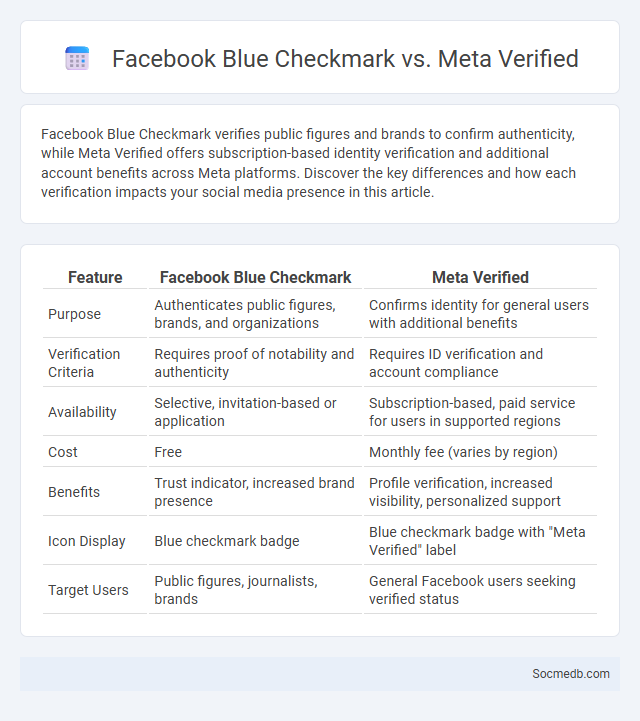
Photo illustration: Facebook Blue Checkmark vs Meta Verified
Facebook Blue Checkmark verifies public figures and brands to confirm authenticity, while Meta Verified offers subscription-based identity verification and additional account benefits across Meta platforms. Discover the key differences and how each verification impacts your social media presence in this article.
Table of Comparison
| Feature | Facebook Blue Checkmark | Meta Verified |
|---|---|---|
| Purpose | Authenticates public figures, brands, and organizations | Confirms identity for general users with additional benefits |
| Verification Criteria | Requires proof of notability and authenticity | Requires ID verification and account compliance |
| Availability | Selective, invitation-based or application | Subscription-based, paid service for users in supported regions |
| Cost | Free | Monthly fee (varies by region) |
| Benefits | Trust indicator, increased brand presence | Profile verification, increased visibility, personalized support |
| Icon Display | Blue checkmark badge | Blue checkmark badge with "Meta Verified" label |
| Target Users | Public figures, journalists, brands | General Facebook users seeking verified status |
Introduction to Social Media Verification
Social media verification establishes the authenticity of accounts, helping You distinguish genuine profiles from impersonators. Verified accounts often feature a distinctive badge that signals credibility and trustworthiness to followers. This process is essential for maintaining integrity on platforms like Twitter, Instagram, and Facebook, ensuring accurate representation of public figures and brands.
What is the Facebook Blue Checkmark?
The Facebook Blue Checkmark is a verification badge that confirms the authenticity of a public figure, celebrity, or brand's official page or profile. This symbol helps users distinguish genuine accounts from fake or fan pages, enhancing trust and credibility on the platform. Verified accounts often gain higher visibility and access to exclusive features, improving engagement and communication with followers.
Understanding Meta Verified: Features and Benefits
Meta Verified offers a range of features including a verified badge, enhanced account security, and priority access to customer support. Subscribers gain increased visibility through better reach and higher ranking in search results, boosting credibility and audience trust. The service supports content creators and businesses by providing tools that promote authenticity and improve engagement on platforms like Facebook and Instagram.
Blue Checkmark Across Social Media Platforms
The blue checkmark across social media platforms signifies verified accounts, confirming the authenticity of public figures, brands, and influencers to users. Platforms like Twitter, Instagram, and Facebook use this feature to reduce impersonation and increase trustworthiness in digital interactions. Obtaining this verification often involves a rigorous application process, including identity verification and adherence to platform-specific guidelines.
Key Differences: Facebook Blue Checkmark vs Meta Verified
The Facebook Blue Checkmark signifies authentic accounts of public figures, brands, or organizations verified through a strict identity confirmation process, ensuring credibility and trustworthiness. Meta Verified is a subscription-based service that provides verified status along with exclusive features like account protection and increased visibility for individual creators and businesses. While the blue checkmark focuses solely on authenticity verification, Meta Verified combines identity confirmation with added benefits to enhance user experience and online presence.
Eligibility Criteria for Each Verification Badge
Social media platforms have specific eligibility criteria for each verification badge to ensure authenticity and credibility. Your account must typically be complete with a verified phone number, email, bio, profile photo, and active presence to qualify. Verification badges often require public interest, such as notable figures, brands, or entities, and platforms may review followers, media references, and account security before granting verification.
Application Process: Step-by-Step Comparison
The application process for social media platforms like Facebook, Instagram, and TikTok involves creating an account, verifying email or phone number, and setting up a profile with personal information and profile pictures. Each platform varies slightly; Facebook requires detailed profile information and interest categories, Instagram emphasizes linking with Facebook and following accounts, while TikTok focuses on immediate content engagement post-signup. Verification steps and privacy settings adjustments are critical across all platforms to ensure account security and personalized content delivery.
Advantages of Being Verified on Facebook and Meta
Being verified on Facebook and Meta significantly enhances credibility by providing an official blue check badge that signals authenticity to users, which can boost trust and engagement. Verified accounts often receive higher visibility in search results and newsfeeds, increasing brand awareness and reach. This status also offers access to advanced features such as priority customer support and protection against impersonation, further optimizing account security and user interaction.
Common Misconceptions About Verification Badges
Verification badges on social media platforms are often mistaken for indicators of personal popularity or endorsement by the platform, rather than confirming the authenticity of an account. Many users believe that obtaining a verification badge guarantees increased content visibility or follower growth, which is not necessarily true. The primary purpose of a verification badge is to help users identify genuine accounts of public figures, brands, or organizations, reducing the risk of impersonation and misinformation.
Which Verification Badge is Right for You?
Choosing the right social media verification badge depends on platform-specific criteria and your account's purpose. Blue checkmarks typically verify public figures, brands, or organizations, signaling authenticity and boosting credibility. Specialized badges, such as Instagram's "Product Expert" or Twitter's "Government Official" verifications, cater to niche roles and industries, helping users distinguish authoritative accounts relevant to their interests.
 socmedb.com
socmedb.com